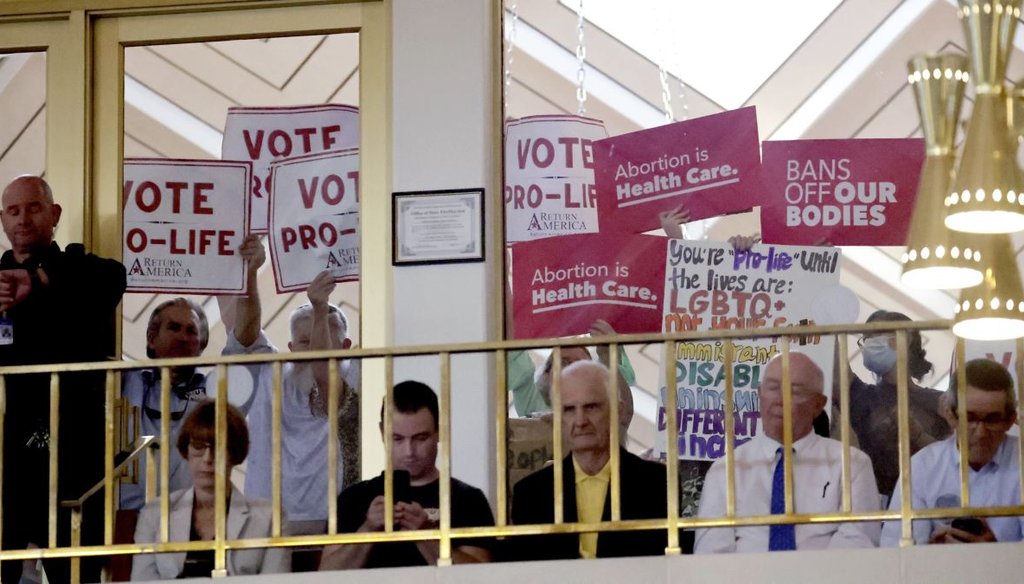Stand up for the facts!
Our only agenda is to publish the truth so you can be an informed participant in democracy.
We need your help.
I would like to contribute

Protesters on both sides of the issue hold signs as North Carolina House members debate new restrictions on abortion on May 16, 2023, in Raleigh, N.C. (AP)
Almost a year ago, the Supreme Court issued its landmark ruling overturning Roe v. Wade, which since 1973 had established federal protections for abortion access up to the point of fetal viability.
In the year since, the national abortion access landscape has changed significantly.
By PolitiFact’s count, 25 states have banned abortion or tightened restrictions on the procedure. The other 25 states and District of Columbia either kept or strengthened Roe-era abortion rights or were definitively blocked from tightening their abortion laws by the voters or courts.
This befits a narrowly divided and polarized nation. The 25 states that have maintained or strengthened abortion laws (or have seen their efforts to tighten laws blocked permanently) are home to 52% of the population. The 25 states that have tightened abortion laws or are fighting in the courts to do so are home to 48%.
Sign up for PolitiFact texts
That’s the same as the breakdown of the 2020 presidential election: Joe Biden won 52% of the two-party vote, while Donald Trump won 48%.
It’s important to note that not every one of those 25 states with new, tougher laws has seen them go into effect. In six states, a more restrictive law has been blocked as a court decides on its constitutionality. In 10 states, the new, more restrictive law is in place with no challenges pending. Nine states have stricter laws in place while litigation against the law continues.
The more stringent laws in those 25 states went into effect for different reasons. Some states, such as Arkansas, Louisiana and Mississippi, had already enacted "trigger laws" that were poised to go into effect shortly after the justices overturned Roe. Other states, such as Indiana and West Virginia, acted after the Dobbs decision came down. Still others, such as Wisconsin, saw an abortion ban passed more than a century ago go into effect once Roe’s protections were lifted.
The abortion restrictions in each state differ in several ways.
In the new batch of stricter laws, the most common gestational ages allowed for abortion is either zero weeks or six weeks. The former would be a total ban at any gestational age. Although the six-week ban allows a little more time, that window often passes before the pregnancy is known, which critics say makes it tantamount to a total ban.
Every post-Roe abortion law includes exceptions for the life of the mother, though states vary somewhat in their definitions and protocols.
There are three other common carve-outs that frequently appear in the new laws.
One is an exception for pregnancy resulting from rape and/or incest. Of the 25 states with tighter post-Roe laws, 12 have exceptions for rape and/or incest. (Again, not all of these states have seen these laws go into effect, given continuing litigation.)
About 27% of the nation’s population lives in a state with a post-Roe law that doesn’t allow an exception for rape or incest, and all but one of those states without a rape/incest exception has its law currently in force. (Litigation continues in Ohio.)
A second exception is for fetuses with medical anomalies or those are not expected to survive pregnancy. Nine of the 25 states have a medical anomaly exception, often defined in different ways.
A third exception is the mother’s health.
An exception for a mother’s health has been written into the laws of 18 states, though the practicalities of qualifying under this exception can be challenging. For instance, it can be unclear how serious a condition must get before medical intervention happens. Doctors have expressed concern that uncertainty about their legal liability might make them reluctant to act, potentially endangering patients.
Exceptions for the mother’s health are related to, but distinct from, exceptions for the mother’s life. The threat to health imposes a lesser standard than that for threat to life, as it often includes risk of severe impairment or injury, not just death. Some states include mental health concerns as justification for ending a pregnancy under the health exception, for example.
Anti-abortion advocates don't have many more targets for tightening abortion laws among the states that have declined to act so far.
Setting aside Iowa, which had a stricter law rejected by the state Supreme Court, only two states in this category voted for Trump in 2020, Alaska and Kansas. And in 2022, Kansas voters rejected a ballot measure that would have made it easier for the state to restrict abortion.
Four other states that have not tightened abortion laws have Republicans in any position of power: New Hampshire (with a Republican governor and full control of the legislature); Virginia (with a GOP governor and one GOP-controlled legislative chamber); Nevada (with a Republican governor), and Pennsylvania (with one GOP-controlled legislative chamber).
However, all four of those states supported Biden in 2020, and three of the four have a degree of Democratic control that would make enacting a strict anti-abortion law unlikely.
Our Sources
Abortion Finder, State Guide to Abortion in Alabama, accessed June 12, 2023
Abortion Finder, State Guide to Abortion in Arizona, accessed June 12, 2023
Abortion Finder, State Guide to Abortion in Arkansas, accessed June 12, 2023
Abortion Finder, State Guide to Abortion in Florida, accessed June 12, 2023
Abortion Finder, State Guide to Abortion in Georgia, accessed June 12, 2023
Abortion Finder, State Guide to Abortion in Idaho, accessed June 12, 2023
Abortion Finder, State Guide to Abortion in Indiana, accessed June 12, 2023
Abortion Finder, State Guide to Abortion in Iowa, accessed June 12, 2023
Abortion Finder, State Guide to Abortion in Kentucky, accessed June 12, 2023
Abortion Finder, State Guide to Abortion in Louisiana, accessed June 12, 2023
Abortion Finder, State Guide to Abortion in Michigan, accessed June 12, 2023
Abortion Finder, State Guide to Abortion in Mississippi, accessed June 12, 2023
Abortion Finder, State Guide to Abortion in Missouri, accessed June 12, 2023
Abortion Finder, State Guide to Abortion in Montana, accessed June 12, 2023
Abortion Finder, State Guide to Abortion in Nebraska, accessed June 12, 2023
Abortion Finder, State Guide to Abortion in North Carolina, accessed June 12, 2023
Abortion Finder, State Guide to Abortion in North Dakota, accessed June 12, 2023
Abortion Finder, State Guide to Abortion in Ohio, accessed June 12, 2023
Abortion Finder, State Guide to Abortion in Oklahoma, accessed June 12, 2023
Abortion Finder, State Guide to Abortion in South Carolina, accessed June 12, 2023
Abortion Finder, State Guide to Abortion in South Dakota, accessed June 12, 2023
Abortion Finder, State Guide to Abortion in Tennessee, accessed June 12, 2023
Abortion Finder, State Guide to Abortion in Texas, accessed June 12, 2023
Abortion Finder, State Guide to Abortion in Utah, accessed June 12, 2023
Abortion Finder, State Guide to Abortion in West Virginia, accessed June 12, 2023
Abortion Finder, State Guide to Abortion in Wisconsin, accessed June 12, 2023
Abortion Finder, State Guide to Abortion in Wyoming, accessed June 12, 2023
AP News, DeSantis signs Florida GOP's 6-week abortion ban into law, April 14, 2023
AP News, Indiana's top court weighing challenge to state abortion ban, January 19, 2023
Indiana General Assembly, Senate Bill 1 - Abortion - Indiana General Assembly, 2022ss1 Session, accessed June 12, 2023
Indiana Capital Chronicle, Indiana governor signs near-total abortion ban, August 5, 2022
Iowa Public Radio, Iowa Supreme Court hears Reynolds' request to reinstate 'fetal heartbeat' abortion law, April 11, 2023
NY Times, North Carolina Legislature Reapproves Abortion Ban, Overriding Governor’s Veto, May 16, 2023
CNN, Judge puts Ohio's six-week abortion ban on hold indefinitely, October 7, 2022
Ohio General Assembly, SB 23, accessed June 12, 2023
AP News, Judge halts South Carolina’s new stricter abortion law until state Supreme Court review, May 26, 2023
NY Times, South Carolina Senate Passes 6-Week Abortion Ban, May 23, 2023
Milwaukee Journal Sentinel, What are abortion laws in Wisconsin nearly a year after Roe v. Wade was overturned? 5 things to know, May 31, 2023
Wisconsin Public Radio, Here’s what to know about abortion access in post-Roe Wisconsin, September 9, 2022
Politico, Walker signs Wisconsin abortion bill, July 20, 2015
AP News, Judge halts Wyoming abortion ban days after it took effect, March 22, 2023
NBC News, Arizona agrees not to enforce near-total abortion ban until next year, October 27, 2022
NY Times, Abortion Bans Across the Country: Tracking Restrictions by State, accessed June 14, 2023
NY Times, Most Abortion Bans Include Exceptions. In Practice, Few Are Granted, Jan 21, 2023
AZ Mirror, Mayes: Effort to revive Arizona’s abortion ban should be dismissed, May 4, 2023
Planned Parenthood Action Fund, Roe v. Wade Overturned: How the Supreme Court Let Politicians Outlaw Abortion, access June 14, 2023
ABC News, Why doctors say the 'save the mother's life' exception of abortion bans is medically risky, June 13, 2022
NY Times, Deadlocked Iowa Supreme Court Leaves Abortion Legal Through 20 Weeks June 16, 2023
U.S. Census Bureau, "Annual Estimates of the Resident Population for the United States, Regions, States, District of Columbia, and Puerto Rico, April 1, 2020 to July 1, 2022"
Email interview with Tara Mancini, director of public policy at Power to Decide, May 24, 2023











































